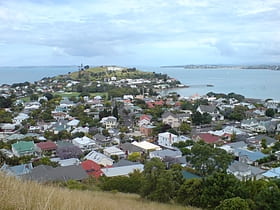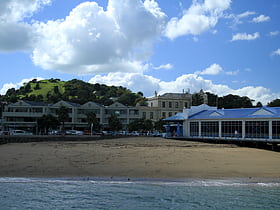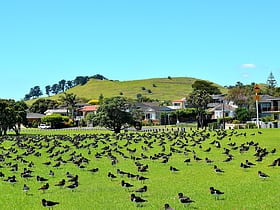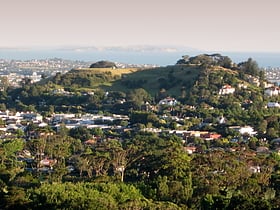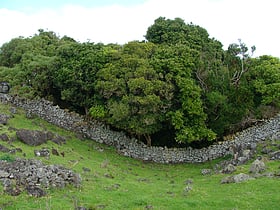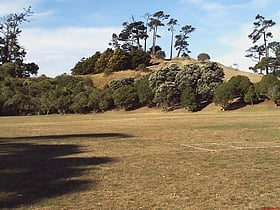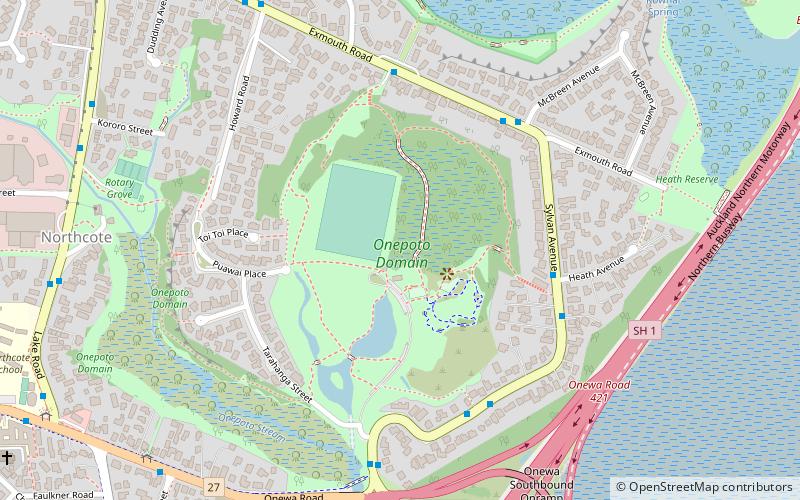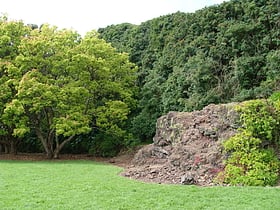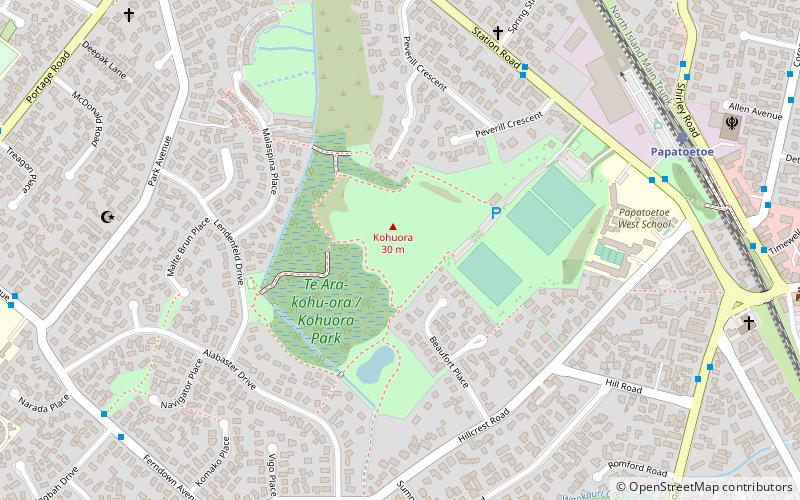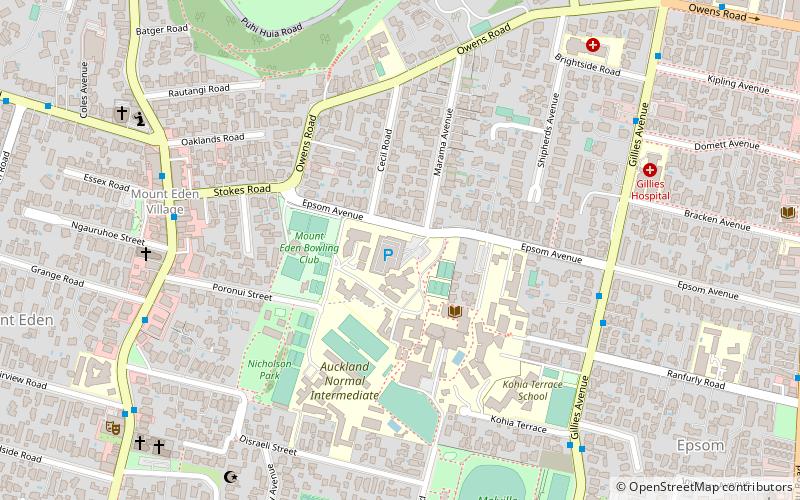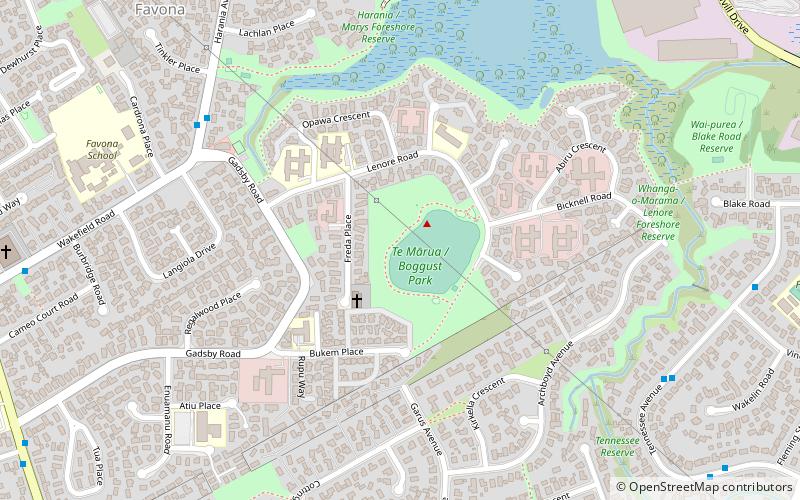Auckland: Natural Attraction
Places and attractions in the Natural attraction category
Categories
- Nature
- Natural attraction
- Volcano
- Park
- Area
- Shopping
- Museum
- Shopping centre
- Concerts and shows
- Bridge
- Church
- Theater
- History museum
- Art museum
- Sport
- Sport venue
- Historical place
- Art gallery
- Arenas and stadiums
- Street
- Sacred and religious sites
- View point
- Specialty museum
- Gothic Revival architecture
- Library
- Music venue
- Island
- Skyscraper
North Head
North Head, known as Maungauika to the local Māori population, is a volcanic headland situated at the entrance of Auckland's Waitematā Harbour in New Zealand. This extinct volcano, one of about 50 in the Auckland volcanic field, offers a unique combination of natural...
Mount Victoria
Mount Victoria, an extinct volcano, stands as a prominent landmark in Auckland, New Zealand. Rising above the suburb of Devonport, this volcanic cone offers panoramic views of Auckland's cityscape and harbor, making it a favored destination for tourists and locals...
Māngere Mountain
Māngere Mountain, a prominent volcanic cone located in the city of Auckland, New Zealand, is a testament to the region's fiery geological past. The mountain is one of the 53 volcanoes that make up the Auckland Volcanic Field and offers a unique glimpse into the area's...
Ōhinerau / Mount Hobson
Ōhinerau / Mount Hobson is a 143 m high volcanic cone in the Auckland volcanic field in Auckland, New Zealand.
Ihumātao
Ihumātao is a location situated three kilometres from Auckland International Airport in Mangere, Auckland in New Zealand. A Māori village once existed there. The New Zealand Ministry for Culture and Heritage gives a translation of "cold nose" for Ihumātao. Māori first settled in the area as early as the 14th century CE.
Pigeon Mountain
Ōhuiarangi / Pigeon Mountain is a 55 m high volcanic cone at Half Moon Bay, near Howick and Bucklands Beach, in Auckland, New Zealand. The cone forms the last part of volcanic activity that lasted many years.
Tank Farm
Tank Farm is the name of a volcanic explosion crater in North Shore City, New Zealand, near the approaches to the Auckland Harbour Bridge. Its Maori name is Te Kopua o Matakamokamo, meaning 'the basin of Matakamokamo'.
Maungawhau / Mount Eden
Maungawhau / Mount Eden is a scoria cone in the Mount Eden suburb of Auckland, New Zealand.
Mount Richmond
Ōtāhuhu / Mount Richmond is one of the volcanoes of the Auckland volcanic field. A group of scoria mounds up to 50 m high, it has two 50 m wide craters.
Onepoto Volcanic Crater
Onepoto is the name of a volcanic explosion crater in North Shore City, New Zealand. It is a part of the Auckland volcanic field.
Mount Cambria
Mount Cambria is one of the volcanoes in the Auckland volcanic field. Located in the suburb of Devonport north-east of Mt Victoria, its 30-metre scoria cone was quarried away. The site is now Cambria Reserve. It was named Heaphy Hill after Charles Heaphy by Ferdinand von Hochstetter in 1859, but this name is not used.
Lake Pupuke
Lake Pupuke is a heart-shaped freshwater lake occupying a volcanic crater between the suburbs of Takapuna and Milford on the North Shore of Auckland, New Zealand.
Little Rangitoto
Little Rangitoto is a volcano in the Auckland volcanic field in Remuera, New Zealand. The name Maungarahiri refers to Rāhiri, an ancestor of Ngāpuhi, who journeyed around the North Island.
Auckland volcanic field
The Auckland volcanic field is an area of monogenetic volcanoes covered by much of the metropolitan area of Auckland, New Zealand's largest city, located in the North Island.
Maungakiekie / One Tree Hill
Peak with an obelisk and a viewing deck Maungakiekie / One Tree Hill is a 182-metre volcanic peak in Auckland, New Zealand. It is an important memorial place for both Māori and other New Zealanders. The suburb around the base of the hill is also called One Tree Hill.
Mount Roskill
Mount Roskill is a suburban area in the city of Auckland, New Zealand. It is named for the volcanic peak Puketāpapa.
Kohuora
Kohuora, located in the suburb of Papatoetoe, is one of the volcanoes in the Auckland volcanic field in the North Island of New Zealand. It has an explosion crater around 600 m wide, 30 m deep and with an irregular V-shape indicating it was formed by at least three explosion crater vents.
Mount Saint John
Mount Saint John is a volcanic scoria cone in Epsom, in the Auckland volcanic field of New Zealand. It has a peak 126 metres above sea level and a crater around 150 m wide.
Mount Albert
Mount Albert is a volcanic peak which dominates the landscape of Mount Albert, a suburb of Auckland.
Meola Reef
Meola Reef, or Te Tokaroa in Māori, is a lava flow forming a reef peninsula across part of Auckland's Waitemata Harbour, New Zealand. The reef extends for over 2 kilometres across the harbour, to within 500 metres of Kauri Point on the northern shore.
Te Hopua a Rangi
Te Hopua a Rangi / Gloucester Park is one of the volcanoes in the Auckland volcanic field in Auckland, New Zealand, and is located in Onehunga. Its 300 m wide, sediment-filled explosion crater was used as a boat harbour in early European times and known first as Onehunga Basin then as Geddes Basin.
Māngere Lagoon
Māngere Lagoon is a lagoon in the Manukau Harbour, New Zealand. It occupies a volcanic crater or maar which is part of the Auckland volcanic field. Oval and about 600m long, it has a small restored scoria island remaining in the centre.
Maungarei
Maungarei / Mount Wellington is a 135-metre volcanic peak located in the Auckland volcanic field of Auckland, New Zealand. It is the youngest onshore volcano of the Auckland volcanic field, having been formed by an eruption around 10,000 years ago.
Te Tatua-a-Riukiuta
Te Tātua-a-Riukiuta is a volcano in Three Kings, New Zealand that erupted 28,500 years ago. The volcano had three prominent peaks and a number of smaller peaks until most of them were quarried away, leaving a sole remaining large peak called Big King.
Taylors Hill
Taylors Hill, is a volcano in the Auckland volcanic field. It erupted about 33,000 years ago. Its scoria cone reaches 56 m high. It was the site of a Māori pā, and retains earthworks from that era such as kumara pits and terracing. It was most likely first occupied in 1400s, and was an area where ōnewa was quarried to make toki.
Hampton Park
Hampton Park is one of the volcanoes in the Auckland volcanic field. A small scoria cone reaching 35 metres above sea level, with a shallow crater around 50 metres wide, which has been modified by quarrying.
Purchas Hill
Purchas Hill is one of the volcanoes in the Auckland volcanic field. Purchas Hill was a twin-cratered scoria cone around 50 metres high, located north of Maungarei / Mount Wellington, before it was predominately quarried away. The scoria cone sat in the middle of its large explosion crater with a surrounding tuff ring.
Pukeiti
Pukeiti is one of the volcanoes in the Auckland volcanic field. The spatter cone is the smallest volcano in Auckland, reaching 30 metres above sea level, and has a shallow crater over 30 metres wide. The crater rim was quarried on the south and east side.
Mount Smart
Rarotonga / Mount Smart is one of the volcanoes in the Auckland volcanic field. Quarrying removed almost all the scoria cone, which was 87 m high. Prior to the arrival of Europeans, it was extensively terraced and used as a defensive pā. The former quarry is now the site of Mount Smart Stadium.
Ōrākei Basin
Orakei Basin is one of the volcanoes in the Auckland volcanic field in the North Island of New Zealand. It has an explosion crater around 700 m wide, with a surrounding tuff ring. After eruption about 120,000 years ago, it became a freshwater lake that had an overflow stream in the vicinity of present Orakei Rd bridge.
Te Pou Hawaiki
Te Pou Hawaiki is a volcano in the Auckland volcanic field in New Zealand. It was a small, low scoria cone south-east of Mount Eden that was quarried away.
Waitākere Reservoir
Waitākere Reservoir is a reservoir on the Waitakere River in the Waitākere Ranges, west of Auckland in New Zealand. Waitākere Dam was completed in 1910 and is a concrete gravity dam with a slight curvature. It has a lake area of 25.1 hectares and a capacity of 1.76 million cubic metres.
Ash Hill
Ash Hill is a volcano in Wiri, in the Auckland volcanic field, in New Zealand. A low tuff cone with an explosion crater about 150m wide, it is now covered by industrial development. It peaked at roughly 30 metres above sea level.
Matukutureia
Matukutūreia is one of the volcanic cones in the Auckland volcanic field. It has a peak 73 metres above sea level, and was the site of a pā.
Matukutūruru
Matukutūruru is a volcano in Wiri, in the Auckland volcanic field. It had a scoria cone reaching 80 metres above sea level, which was quarried away. The lava flows created 290m long Wiri Lava Cave. The hill was the site of a pā. In late 2011 the quarry lake was drained and fill-dumping began on the site.
Boggust Park Crater
Boggust Park Crater is a volcano in the Auckland volcanic field, New Zealand. Located in the Favona area of the Mangere suburb, it is one of Auckland city's older volcanoes. It was first recognised as a volcano in 2011.
Grafton Gully
Grafton Gully is a deep and very wide gully running northwards towards the sea through the volcanic hills of the Auckland volcanic field in New Zealand. It divides the CBD from the suburbs of Grafton and Parnell in the east.
Wiri Lava Cave
Wiri lava cave is Auckland's longest known lava cave at around 290 metres. It is part of Matukutūruru volcano, in the Auckland volcanic field. Because it features rare lava stalactites the cave has garnered international renown. The cave entrance is locked and entry is by permit only.
Pukewairiki
Pukewairiki is a volcano in the Auckland volcanic field in the North Island of New Zealand. Pukewairiki has an explosion crater around 500 m wide, and a tuff ring up to 30 m high, which has been eroded away on the south-western side.
Waitomokia
Waitomokia is a volcano in the Auckland volcanic field. Waitomokia's 600 m wide tuff crater contained three small scoria cones up to 20 m high, one with a crater, which were quarried in the 1950s.
Map

